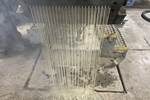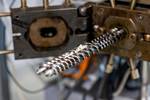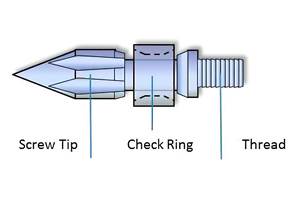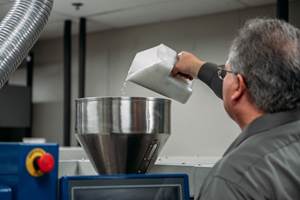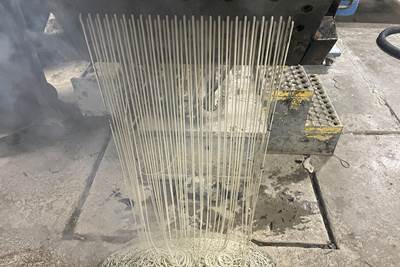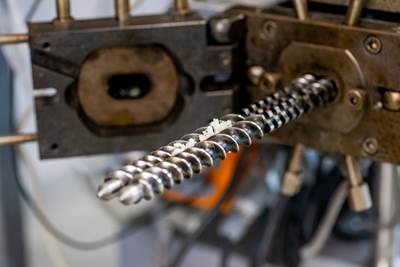Purging Compounds & Process Efficiency: Why They Must Work in Tandem To Improve Your Bottom Line
More and more plastics processors are using commercial purging compounds to clean out their systems and help them switch from one product run to the next as efficiently as possible. But quality purging compounds aren’t cheap, nor are they a standalone solution.
In many cases, quality, effective purging compounds cost more on a per-pound basis than the resins they are flushing out, which is disconcerting to some facility managers who must work within a tight budget. They also require the following specific processes to transition between colors and resins with minimal downtime.
The Relationship Between Purging Compounds and the Process
If only it were as easy as pouring a purging compound into your injection molding machine so you can sit back and watch the magic happen. The reality, however, is that each type and grade of purging compound behaves differently under different temperatures, pressures and soak times.
That’s why it’s important to partner with a purging compound manufacturer who looks at your processes from a holistic standpoint before making the best recommendations for your machine type. Along with recommending the proper purging compound grade, your provider should also make recommendations to maximize performance.
So, how can you, as a plastics processor, tell that the purging compound and your processes are working well together? The obvious indicator is that your changeovers are fast and efficient. However, the real improvements are revealed in the data. It is vital that you monitor and track the results of your new process implementations.
A Tier 1 automotive molder was experiencing high scrap rates and began recording the data of defect rates over time. It found a pattern that defect rates decreased each time after the company manually cleaned the screw but climbed again rapidly in two months. The molder implemented a new purging program in October that helped reduce defect rates steadily down to well under 1%.

A preventive purging program helped a Tier 1 automotive molder reduce scrap rates from 10-15% to less than 1% shortly after it was implemented in October. Source (all images): Asahi Kasei Plastics North America
Three Common Errors To Avoid During the Purging Process
There are three common errors plastics processors make when attempting to purge:
1. Using a Cheaper Virgin Resin or Regrind To Purge: To save money, plastics manufacturers believe using a cheaper virgin resin will address their purge problems before using a higher quality commercial purge compound. However, this tends to make purge problems even worse. “Old-school” purging methods, such as flushing the machine with the next resin or regrind, are time-consuming, material-wasting, and ineffective in removing color and carbon contamination. These materials are not designed to clean machines. When using regrind or virgin resins to purge, the material simply creates another layer over any resins, color deposits or carbonized material within the barrel.
2. Selecting a Purging Compound Based on the Wrong Criteria: The following are a few examples of how you might be selecting (and evaluating) a purging compound based on the wrong set of standards:
- Determining a purging compound’s overall value based on price-per-pound alone
- Not knowing what your current purge costs are before evaluating a commercial purge compound’s effectiveness on the process
- Failing to consider other critical purge factors, such as machine downtime, amount of purge needed for an effective clean, amount of replacement resin needed to remove purge from the machine and scrap rates.
3. Not Following the Supplier’s Recommended Purging Procedures: This cannot be stressed enough — you must document specific instructions to share with anyone who is involved in your purging procedures.
You would be surprised by how many facilities are out there just … running. They don’t have documented purging processes at the machines, nor do they monitor their purging processes.
‘Old-school’ purging methods are time-consuming, material- wasting, and ineffective in removing color and carbon contamination.
When you lack consistency in purging practices — from person to person and shift to shift — you should not expect great results. It’s a huge and costly mistake to let instruction and guidance from the experts and manufacturers of the product go unacknowledged.
Also, failure to lean on your purging compound representative for advice is detrimental to process improvement. A common weakness in trying to optimize a process is a lack of general processing knowledge or unawareness of the concept of heat history or ways to minimize resin degradation.

Sheet extrusion requires precision. Inconsistent layers, gels or discoloration can turn entire rolls into scrap. Unfortunately, the way many processors handle color or material transitions makes things worse.
Continuous Training and Education Are Not Optional
The following is an all-too-common problem for plastic processors that are implementing a new purging compound into their process: Your purging procedures start out being followed to the letter, with consistently outstanding results. However, little by little, changes are made to personnel or adaptations are made to these procedures until procedures are no longer recognizable. Eventually, those excellent results you were once so happy about are now inconsistent and everyone is asking, “What happened?”
This is why ongoing training and education are critical factors in maintaining sustainable purging process efficiency. Although your purging compound manufacturer should offer several ways to train your workers (both onsite and off) on proper purging procedures, there are a few things you can do in-house to continually and effectively implement training.
Implementing Correct Purging Processes
The golden rule of maintaining proper purging procedures is to establish a process and document it. If you notice new improvements you want everyone to start implementing, update the document. Keep that process setup sheet at the machine and then monitor the process a couple of times per shift. Please note: If you have a small process window, or you are producing tight-tolerance parts, you will need to monitor at a higher frequency.
The second rule of maintaining proper purging procedures is to monitor the variables to identify a number of issues. Variables include, but are not limited to, machine issues such as:
- Excessive wear on the screw, barrel and check ring;
- Pressure loss issues;
- Actual mold temperature;
- Water flow on the tooling
- Incorrect plumbing of water lines;
- Contamination buildup inside the water ports.
Many of the above machine issues lead to production material viscosity changes, which create process nightmares. However, when you monitor these variables and implement processes quickly and efficiently to solve the issue at hand, you should see the beneficial results right away.
The golden rule of maintaining proper purging procedures is to establish a process and document it.
Evaluating Purging Compound Manufacturers
Any effective purging process starts with an innovative, quality line of purging compound product grades. Here are a few factors to consider:
- Look for a manufacturer that offers a wide variety of purging compound grades best suited to your specific purging needs.
- Qualify that the purging compounds are engineered specifically for purging resin to facilitate material and color changes quickly.
- Ask the manufacturer if they provide detailed, step-by-step instructions and purging tips to help optimize your process.
- Try a sample to ensure the purging compounds offer more cleaning power and superior performance than other products on the market.
About the Author: Thomas Hanvey is associate director of marketing & sustainability for Asahi Kasei Plastics North America and Asaclean Purging Compounds. In this role, he leads lead the strategic marketing efforts for both brands, driving growth, brand awareness and sustainability initiatives. Hanvey joined Asahi Kasei in 2016. From 2016 through 2023, he oversaw marketing for Asaclean Purging Compounds in North and South America. Hanvey is an MBA candidate at Indiana University’s Kelley School of Business and co-chairs the Asahi Kasei North American Marketing Council. Contact: 551-502-0680; tom.hanvey@akplastics.com;
Related Content
Got Streaks or Black Specs? Here’s How to Find and Fix Them
Determining the source of streaking or contamination in your molded parts is a critical step in perfecting your purging procedures ultimately saving you time and money.
Read MoreMarket Changes Spur Industrial Recycler to Enhance Capabilities in Clear Plastic Reprocessing
Butler MacDonald found new ´óĎó´«Ă˝ and flexibility thanks to a big step-up in purging efficiency.
Read MoreBest Practices for Purging PHA and PHA/PLA Blends
Because bioplastics are processed at lower temperatures, purging between jobs requires a different process and purging agents than those applied for traditional resins.
Read MoreA Purge Solution for the Blow Molding and Compounding Industries
New commercial purge compounds for new industries from Chem-Trend.
Read MoreRead Next
Use Purging Compounds to Mitigate Processing Challenges of PCR and PIR
With frequent purging, you can minimize serious contamination issues and get both better results and higher profits.
Read MoreRun Lots of Colors? Time to Consider a Commercial Purging Compound
Processors who use commercial purging compounds will see a reduction in scrap levels, machine downtime and overall cost.
Read MoreBest Practices for Purging PHA and PHA/PLA Blends
Because bioplastics are processed at lower temperatures, purging between jobs requires a different process and purging agents than those applied for traditional resins.
Read More